
Read more to find our 8 tips on how to make your classroom culturally inclusive year round, and see book recommendations for young children. 📖
This time of year hosts a variety of traditional celebrations from different cultures all over the world. However, many of these celebrations are often overshadowed by one or another.
A general lack of awareness means a lot of celebrations and cultural practices do not even get acknowledged, especially in schools and childcare centers, which also means a missed opportunity for children to explore the larger world around them.
This lack of awareness is not limited to the winter holidays, and I often think about what it feels like to have an important part of your identity, culture, or family background pushed to the side while others share the privilege of celebrating their identities and cultures in the forefront.
If you think about it, acknowledging the feelings of others who have lived experiences different from your own, trying to understand the reasons behind these feelings, and empathizing with others to find solutions that will make everyone feel included are all skills that are rooted in and connected to social-emotional learning (SEL).
As educators, we have an incredible opportunity and responsibility to support the development of these skills with even our youngest learners.
Celebrating diversity is a huge part of building the empathy and perspective-taking skills necessary for the development of kind, inclusive, caring human beings.
As an educator of young children, I have learned the value that comes from the acknowledgment of cultures, practices, and holidays that are both similar and different from the ones I celebrate or participate in personally.
I’ve seen the joy on the faces of the children in my class when they get to teach me words in their first language, share their favorite cultural dish, or read a story where the main characters look just like them.
They truly feel seen, respected, and validated in who they are – all things that contribute to their development of a positive sense of self and pride in what makes them unique.
My co-teachers and I have learned so many different things from our students and their families. One of my favorite parts of teaching is inviting families into the classroom to share a story, tradition, or part of their culture that is important to them, making it that much more important to us all.
I am reminded time and time again that this learning, joy, and celebration should not be limited to the holiday season, but now is the perfect time to check in and make sure that we are making our classrooms the best and most culturally inclusive learning environments they can be.
But where do we start?

Children learn best through nurturing, positive, and responsive relationships. Teachers and caregivers are children’s key socializers and have a tremendous impact on their development through the ways we model for, respond to, and guide them.
By openly engaging in conversations about race, ethnicity, sexual orientation, religion, abilities, physical appearances, and family backgrounds in age-appropriate ways, you are sending the message that these aspects are important and make us who we are.
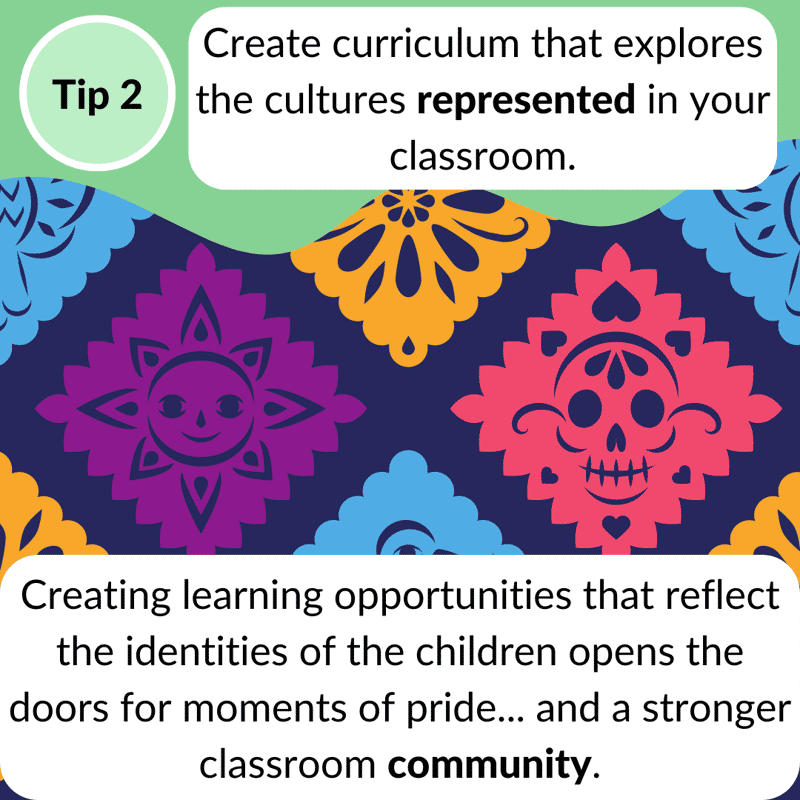
The more that children can relate to what they are learning about, the more meaningful and impactful the learning experience will be.
When educators create learning opportunities that reflect the diverse identities of the children in their class, we open the doors for moments of pride in one’s culture, learning about the perspectives and experiences of others, and building a stronger classroom community.
Children will feel seen, heard, validated in who they are, and understood, which in turn creates a solid foundation for empathy and emotional understanding.
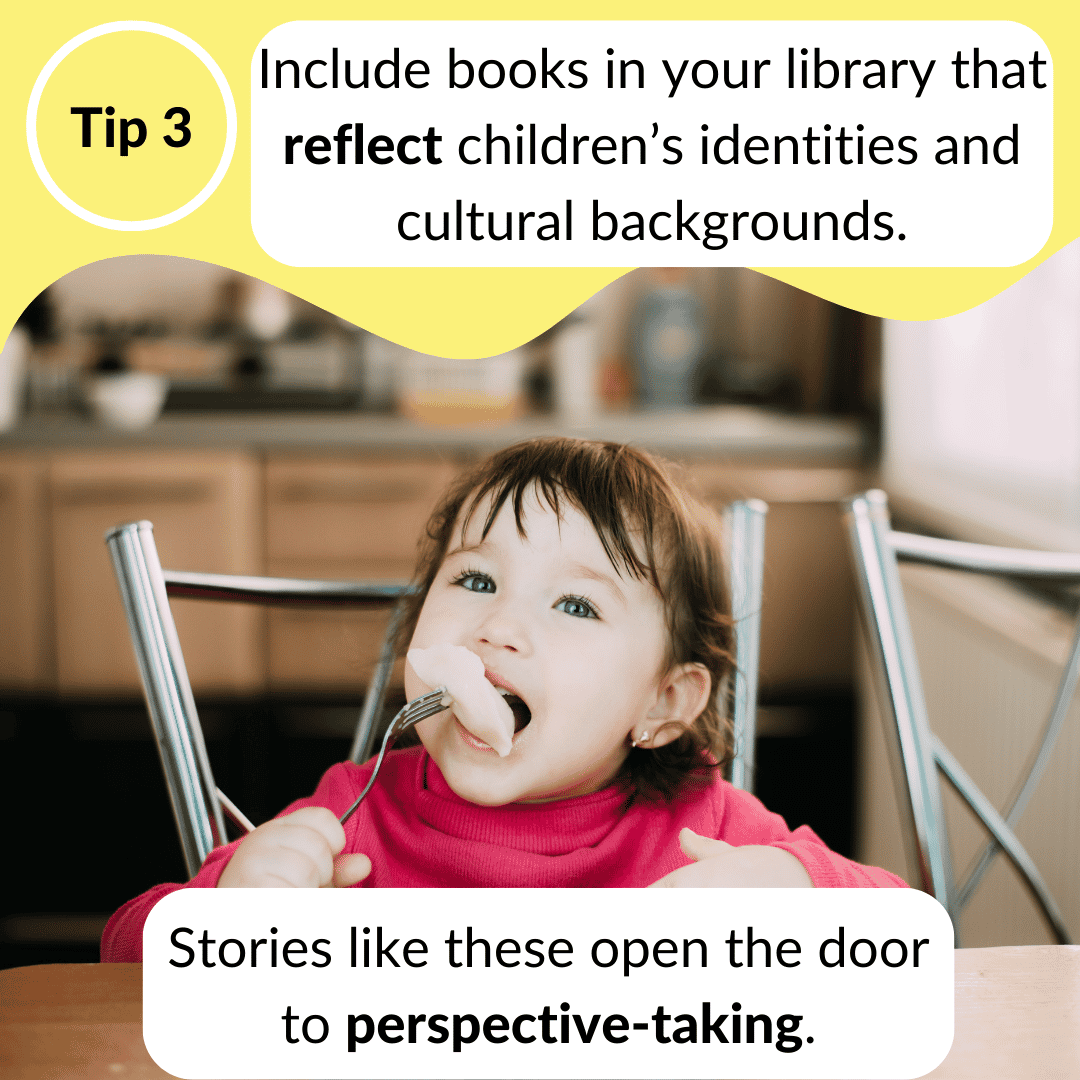
Books like this allow children to process their own challenging emotional moments through the safety and creative visual lens of a story.
Stories like these include diverse characters and either mirror the identities and real-life experiences of the children in your class or open the door to a world where children can practice perspective-taking and learn about experiences that are different from their own.
When you include books with these elements in your classroom, children will not only feel seen, but they can learn about the emotions of different characters, what caused these emotions to arise, how the characters expressed their feelings, how they solved problems, and how they helped themselves feel better.
These are all valuable emotional intelligence skills that will set children up for success in school and life.
.png?quality=low&width=600&height=400&name=Culturally%20Inclusive%20Book%20Recs%20for%20Infants%20and%20Toddlers%20(1).png)
Central America,¡mira, mira, mira! Written by Araceli, Edith and Juliana, Illustrated by Shurjo Mukhi
Clap Hands by Helen Oxenbury
I Can Do It Too! Written by Karen Baiker, Illustrated by Ken Wilson-Max
We All Play kimêtawânaw by Julie Flett
Hair Book Written by Latonya Yvette, Illustrated by Amanda Jane Jones
Love Makes a Family by Sophie Beer
Baby Goes to Market Written by Atinuke, Illustrated by Angela Brooksbank
.png?quality=low&width=600&height=400&name=Culturally%20Inclusive%20Book%20Recs%20for%20Preschool%20(4).png)
Theo’s Deliciously Different Dumplings Written by Dr. Donna Housman, Illustrated by Renee Andriani
Festival of Colors Written by Kabir Sehgal and Surishtha Sehgal, Illustrated by Vashti Harrison
Meesha Makes Friends by Tom Percival
Asian Adventures Delicious Foods from A-Z Written by Yobe Qiu, Illustrated by Cynthia Li
The Day You Begin Written by Jacqueline Woodson, Illustrated by Rafael Lopez
We Move Together Written by Anne McGuire and Kelly Fritsch, Illustrated by Eduardo Trejos
My Shadow is Purple by Scott Stuart
Mindy Kim and the Yummy Seaweed Business Written by Lyla Lee, Illustrated by Dung Ho
Listening with My Heart Written by Gabi Garcia, Illustrated by Ying Hui Tan
Hair Love Written by Matthew A. Cherry, Illustrated by Vashti Harrison
Moonlight Memories Written by Amanda David, Illustrated by Michelle Jing Chan *Available for preorder at time of this post
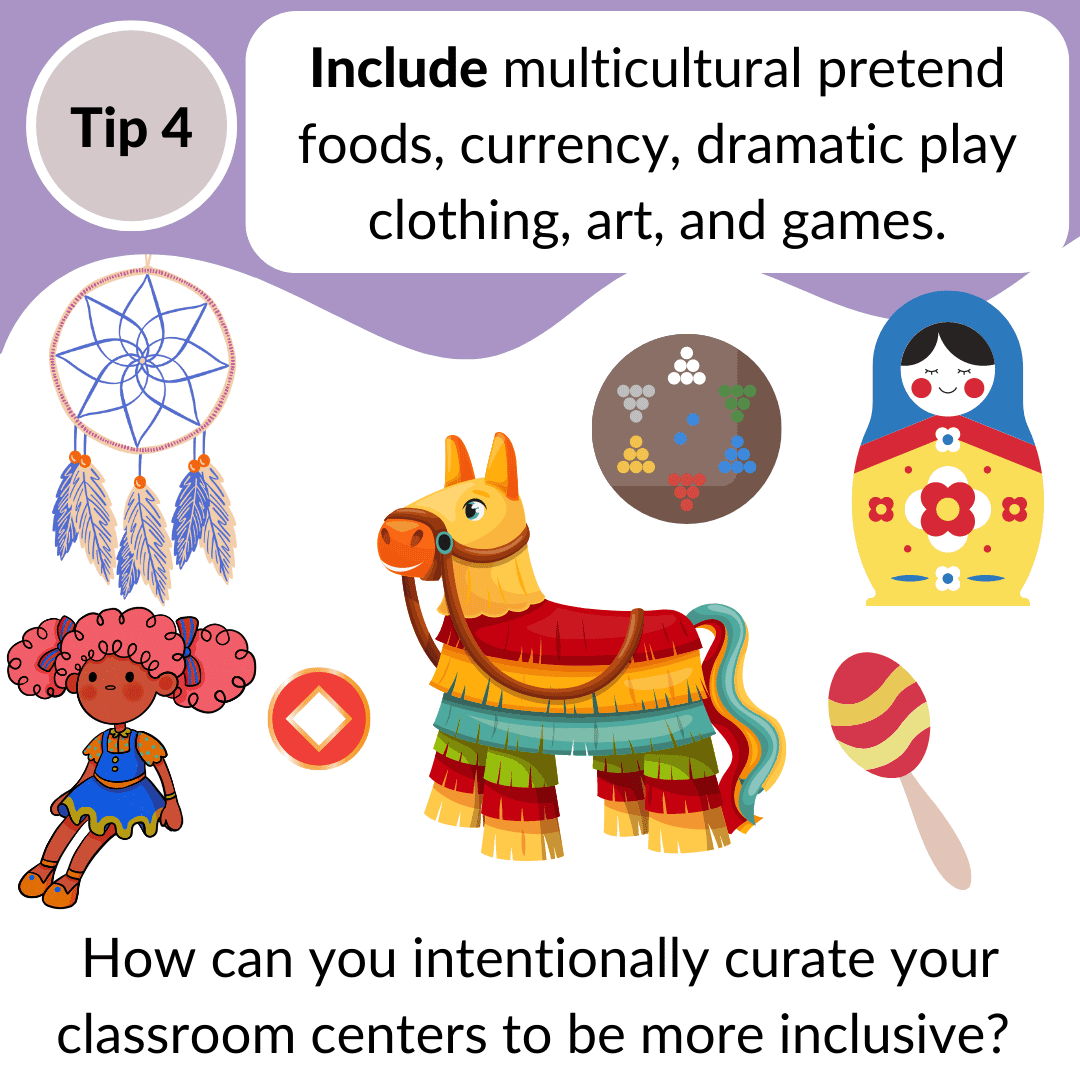
This may seem like an easy step, but even the easiest adjustments to our routines can make all the difference! Take stock of the materials you have in each of your classroom centers, the art or posters you have up on your walls, and the toys or games you set out for children to play with.
Are they representative of the children in your class? Do they prompt questions and learning opportunities about different cultures? How can you intentionally curate your classroom centers to be more inclusive?
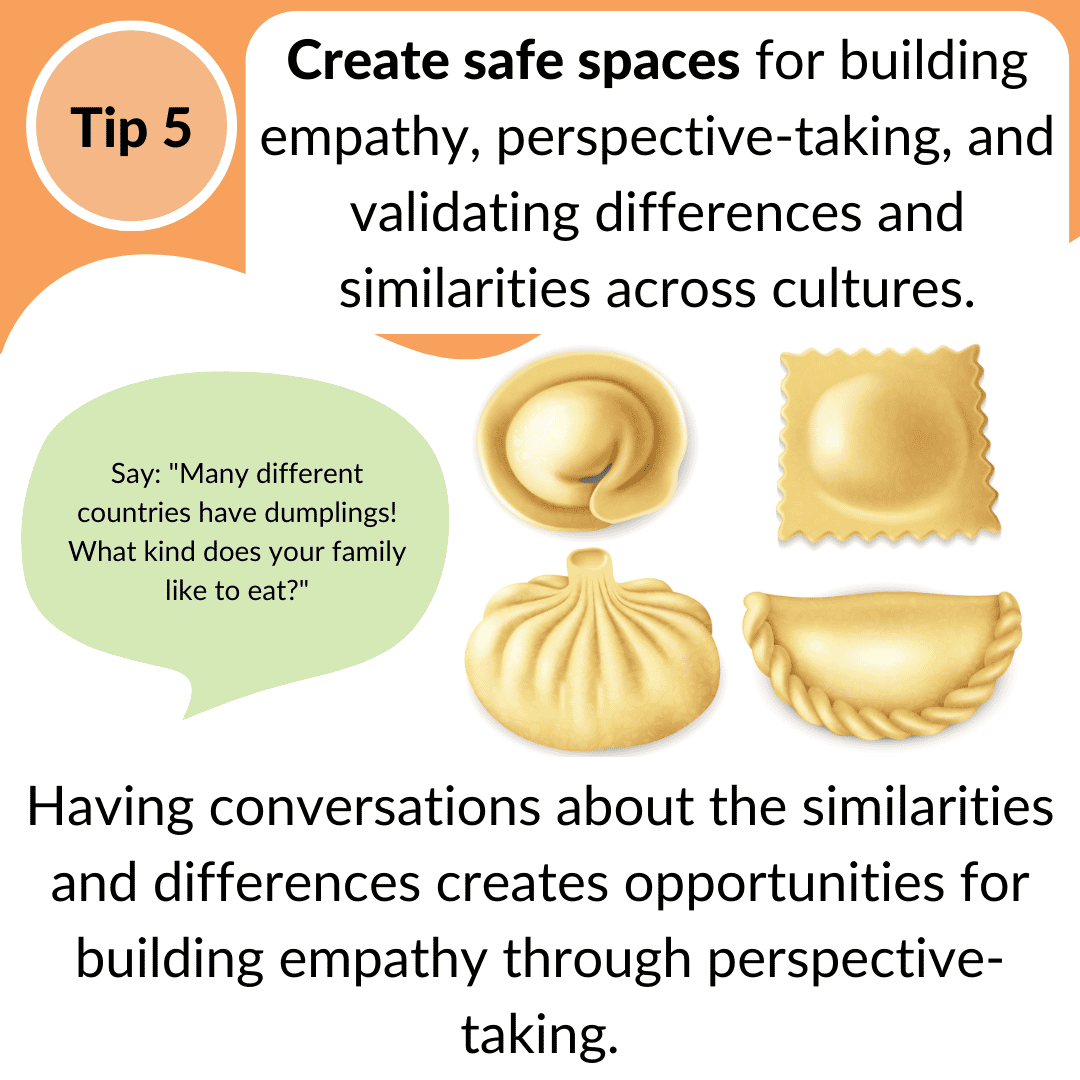
Our differences are what make us... us, but we also share similarities that we may not be aware of. Having conversations about the foods we like, the clothing we wear, our physical features, and our likes and dislikes along with the similarities and differences between them is not only important for children’s development but also creates opportunities for building empathy through perspective-taking.
For example:
“Many different countries and cultures have their own version of dumplings, which are made with dough and filled with different meats or vegetables. In Poland, where my family is from, they are called 'pierogi.' In Japan, there are some called 'gyoza,' Italy has 'ravioli' or filled pasta dumplings, and in Korean cultures, they have dumplings called 'mandu.' What kind of dumplings does your family like to eat?”
These conversations get the ball rolling for children to begin talking with each other about their interests, cultures, and backgrounds. The language you use serves as a model for children to communicate appropriately with each other as they explore perspectives different than their own.
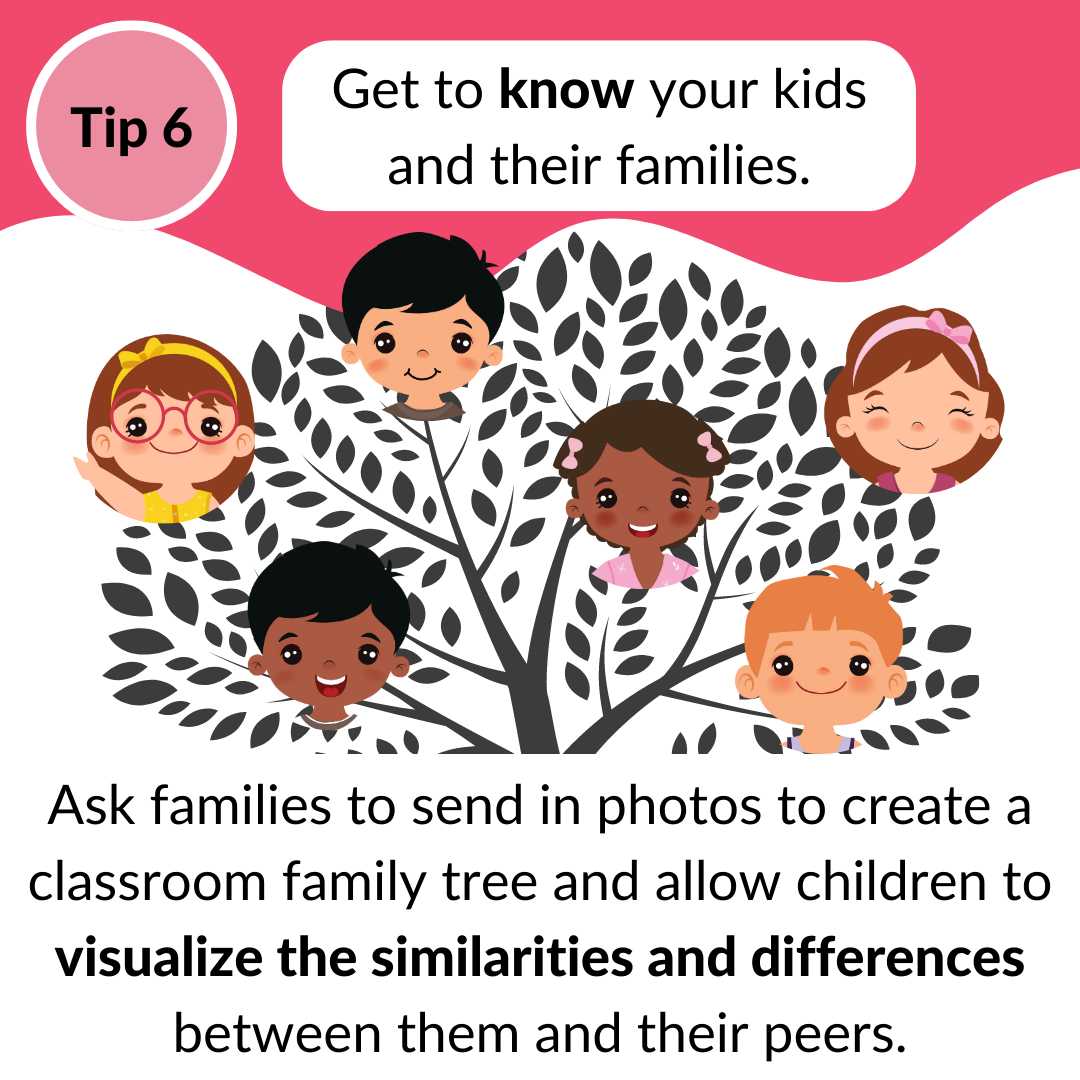
There are so many ways to reach out and highlight all the important parts of the lives of the children in your class. Try planning home-school connection events like a cultural or “favorite family food” potluck, a show-and-tell centered around family traditions or special items, or monthly classroom breakfasts that allow families to connect with one another.
Ask families to send in photos of each family member to create a classroom family tree and allow children to visualize the similarities and differences between them and their peers. You can even create a Classroom Celebration Calendar by asking what each family celebrates and making a calendar note to acknowledge these celebrations when they roll around.

Children are constantly learning by observing, imitating, and asking questions. It is very possible that they may make comments or assumptions, or ask questions about unfamiliar things without compassion or understanding.
It is our job to guide children to understand and be kind when presented with differences, whether they be cultural or physical. Be sure to listen and respond appropriately when children share about or ask questions and address unacceptable behavior or language as a learning opportunity.
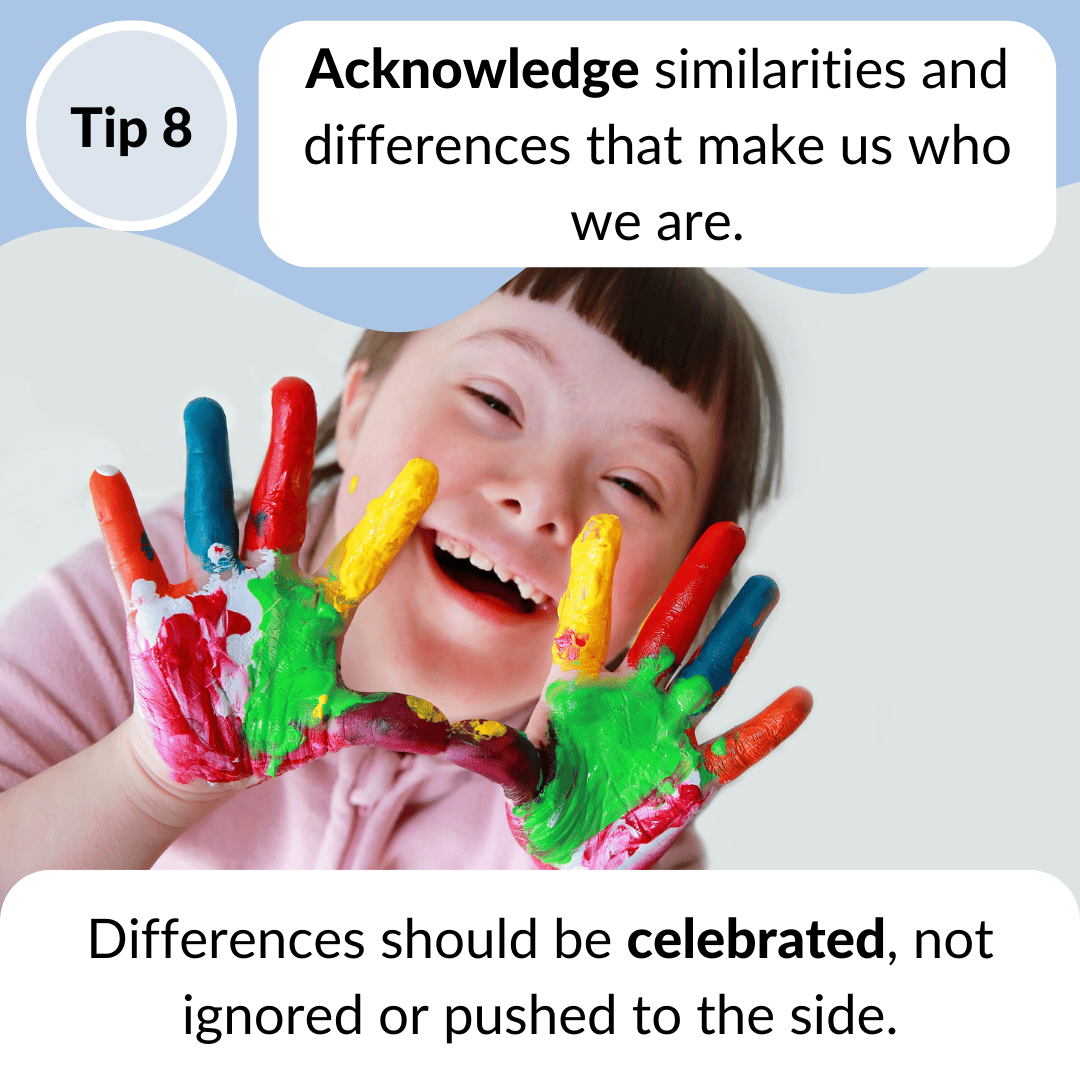
We all get to know ourselves and each other a little bit more each day, especially our youngest learners. They are constantly trying to figure out the world around them as well as who they are.
Make time for activities, conversations, and stories that highlight the many similarities and differences between and among us that make us who we are.
This can be as simple as, “My favorite color is green, what’s yours?” or a fun all-about-me self-portrait activity where children can express themselves in the ways that they see themselves.
Remember that differences should be celebrated, not ignored or pushed to the side. They are what make us, us.
Incorporating these ideas into your classroom routines, practices, curriculum, and environment can make all the difference to the children in your class and their families. And most importantly, these celebrations of differences and what makes each of us unique shouldn’t only happen when we are reminded of them around the holidays.
Sprinkle in this important learning often and make every day count, year-round.
Know someone who may like this content? Sharing is easy with the links below! ↓
These Posts on Children's Books
Housman Institute, LLC
831 Beacon Street, Suite 407
Newton, MA 02459
info@housmaninstitute.org
(508)379-3012
Explore
Our Products
Legal
Connect
Contact
Join our Mailing List!
Subscribe to receive our newsletter, latest blogs, and SEL resources.
We respect and value your privacy.
No Comments Yet
Let us know what you think